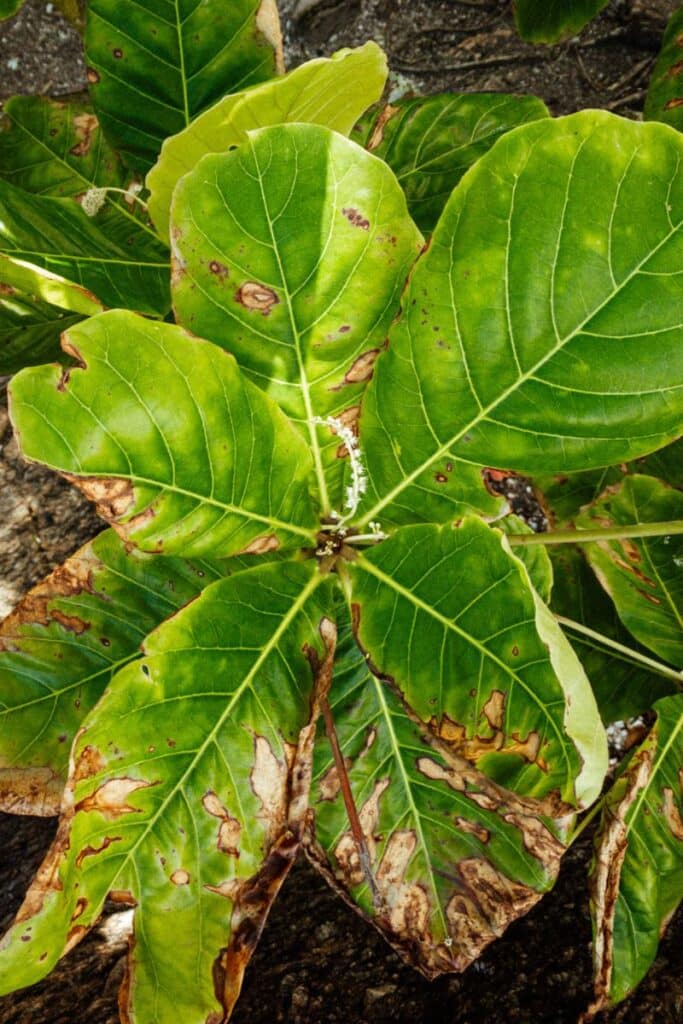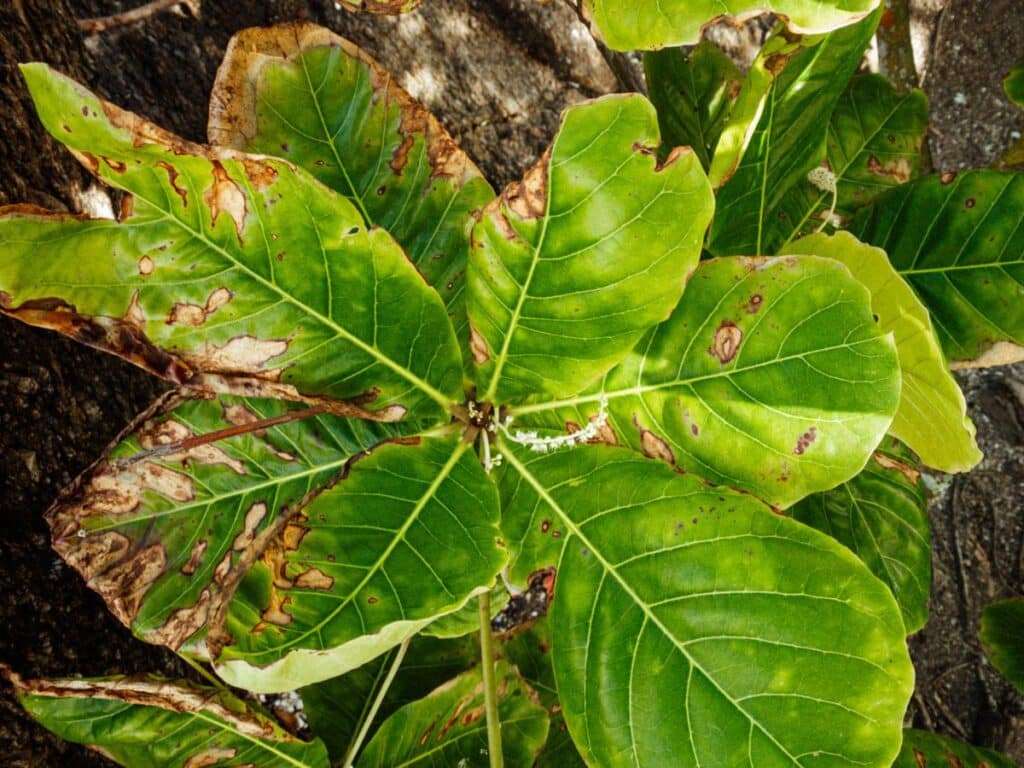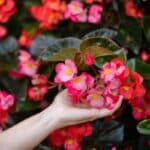The fiddle-leaf fig (Ficus lyrata)—also known as the banjo fig—is a popular tree that is often kept as an indoor plant. The fiddle-leaf fig can be grown outdoors if you are in growing zones nine through eleven; however, this region doesn’t cover much of the United States, hence the popularity as an indoor addition to your home.
The primary draws that many gardeners have towards the fiddle-leaf fig include its large leaves (hence the dark brown spots on fiddle leaf fig plants can be a big issue), the height of the tree, and the speed at which these trees can grow when cared for properly.
The leaves on a fiddle-leaf fig can grow to be more than a foot wide in either direction; however, they are likely to stay closer to the eight-inch mark when kept inside.
Indoor trees are generally kept at heights of six to eight feet—thanks to standard ceiling height—but have the potential to reach ten feet in height.
When grown outdoors in the proper growing zones, you can expect anywhere from 15 to 25 feet in height. In their natural, tropical climate, these trees have been known to reach heights of 50 feet.
Why is My Fiddle-Leaf Fig’s Leaves Turning Brown?
When you have a tree as beautiful as the fiddle-leaf fig growing in your home, the last thing you want to see is damage on the large, glossy leaves.
Unfortunately, the fiddle-leaf fig is prone to browning leaves when conditions are not ideal—yes, this plant could be considered picky. If you have a fiddle-leaf fig with browning leaves or brown spots, read on! There are many different possibilities for why this may be happening.
Root Rot from Overwatering
This is one of the most common reasons for any problem with a fiddle-leaf fig. Root rot. Root rot most often occurs when a plant is overwatered, saturating the soil and creating a breeding ground for fungal and bacterial infections.
These infections cause damage to the root system, leaving them weakened and unable to absorb water and nutrients properly, leading to plant damage such as browning leaves.
Many well-intentioned plant owners have the urge to water their plants anytime it crosses their minds—who doesn’t want to provide the best care for their plants?
Unfortunately, this is more likely to cause harm than be helpful. As a general rule, fiddle-leaf figs should only need watered at a maximum of once per week. It is important to allow the soil to dry out completely in between each watering.
Sunburn From Too Much Direct Sunlight
Another common problem that may be causing your fiddle-leaf fig’s leaves to brown is sunburn. The leaves on this tree are not designed for too much direct sunlight, meaning that too much sunlight can damage the layers of the leaf—very similarly to how the sun can cause sunburn on our skin.
Fiddle-leaf figs do best with indirect sunlight for as much of the day as possible. For indoor plants, consider placing your tree somewhere closer to the center of a well-lit room as opposed to right in front of a window that receives several hours of direct sun each day.
Soil That Drains Poorly
If you are confident that you aren’t overwatering your fiddle-leaf fig, yet root rot continues to be a problem, consider the soil in which you have your tree planted.
Fiddle-leaf figs require soil that drains well, such as a loamy soil. Using poor fiddle leaf fig soil that does not have good drainage qualities can lead to oversaturation of the soil, bringing you to root rot issues.
Too Close to Heaters or Drafts
When choosing a spot for your fiddle-leaf fig, be sure to keep it out of the direct path of air vents or areas that may receive cool drafts.
Cold air conditioning coming out of your vents, or a cool draft coming in under a door or window, can cause issues for your fiddle-leaf fig.
These tropical trees won’t appreciate the cold rush of air like we do in the summer, potentially causing the leaves to damage or brown in protest.
Although the fiddle-leaf fig is a tropical plant, it is also better to keep them away from air vents and heaters that are blowing warm air.
Although the temperature may not be a direct issue, the sudden change in temperature can be. In addition, our indoor heat is often very dry, particularly in the immediate areas surrounding the vents; dry heat can be harmful to the leaves of the fiddle-leaf fig.
Low Humidity
Fiddle-leaf figs are native to tropical climates, meaning they are accustomed to growing in areas with very high humidity.
While these plants can adapt to growing inside—where we generally prefer to keep the humidity at a level more comfortable to humans—humidity levels that are too low can still be an issue.
This is usually more of an issue in the winter when furnace systems are running to keep the indoor temperature at a comfortable level.
While this helps regulate temperature, most common systems dry out the air, lowering the humidity. Spraying your tree with a mister during watering can help keep the humidity levels at a more ideal level.
Underwatering
While overwatering is a more common issue, underwatering can also cause your fiddle-leaf fig’s leaves to brown. When a plant doesn’t receive enough water, several signs of damage may begin to show, including browning leaves and leaf drop. Water is necessary for growth and survival, and the fiddle-leaf fig is no exception.
In addition to drying up, a lack of water also means a lack of nutrients. Plants obtain some of their nutrients directly from the water, but when the root system begins to dry up, it may lose the ability to absorb nutrients from the soil as well.
Bacterial Infection
While root rot can be caused by bacteria, there are other bacterial infections that may cause your fiddle-leaf fig’s leaves to brown.
There is an abundance of various bacteria that can grow and damage plants, so odds are you won’t know what type of bacteria is causing the problem; however, most bacterial infections can be treated and avoided the same way.
Bacterial infections can be caused by human hands, potting tools, animals, and more. If you suspect a bacterial infection, it is important to remove any infected areas on your plant and clean up any plant debris hanging around. It is also generally a good idea to repot your plant in new soil.
Insects
Although you probably don’t want to think much about insects in your home, plants can be an attractant to many small insects, and an infestation can cause harm to your plant.
Insects can cause damage by feeding on the leaves, stems, or roots of a plant, such as the fiddle-leaf fig. When any part of the plant is damaged, the stress that it produces may cause the leaves to start to brown. The most common insects to attack a fiddle-leaf fig are aphids and thrips.
Edema
Another potential cause for browning leaves on your fiddle-leaf fig is edema. Edema is an ailment in which fluid becomes trapped in an organism’s tissue (this can be animal or plant tissue) often causing swelling.
In a fiddle-leaf fig, edema can cause both red spots and brown spots. In general, the brown spotting is a result of the burst tissue once the fluid pressure becomes too great.
Edema is not always an immediate issue for a fiddle-leaf fig; it happens often when a plant is young and requires extra water to support growth.
However, overwatering your fiddle-leaf fig to a point where the roots are taking in more water than the plant needs can cause edema that leaves lasting damage to your fiddle-leaf fig.
Lack of Nutrients
Fiddle-leaf figs, particularly those that are potted, generally require regular fertilizing to sustain the required amount of nutrients they need to grow and sustain their growth.
A fiddle-leaf fig that lacks the nutrients it requires can show various signs of damage, including browning leaves.

How Do You Fix Brown Spots on Fig Trees?
If you’ve started to notice brown spots on your fiddle-leaf fig, you are probably looking for a solution about how to reverse the damage and save your tree.
As with most plant ailments, the best place to start is figuring out what the issue is so you are better prepared to fix it.
Figure Out the Cause
While brown spots on leaves may seem like kind of a generic issue, there are actually ways to narrow down the problem by taking note of where the brown spots are occurring within the leaf, what shade of brown they are, and how much of the leaf they are affecting.
When it comes to a watering issue, the location of the brown spots will help determine how you need to adjust your watering schedule. If your fiddle-leaf fig is suffering from overwatering or retaining too much water, you will likely notice brown spots towards the middle of the leaves.
If your plant is not getting enough water, the brown leaf edges will appear, and the leaves may also start to curl inwards.
If your fiddle-leaf fig is getting too much direct sunlight, the brown spots on its leaves may appear light in color. Leaves that are damaged by sunlight may also have a red or yellow tint to them depending on the level of exposure.
While the brown spots are similar when a fiddle-leaf fig is exposed to either a cold draft or forced-air heat, it’s the accompanying symptoms that will give away the issue.
If cold drafts are the cause, the leaves are likely to begin to wilt once the brown spots occur. If the issue is heat coming from a vent or heater, the leaves may start to crack along with having brown spots.
Trim Back the Leaves So New Growth Can Appear
When brown spots have started to take over some of the leaves on your fiddle-leaf fig, it is generally a good idea to remove them.
By removing the damaged leaves, you are giving the plant the opportunity to focus its energy on growing new, healthy leaves as opposed to wasting energy on the leaves that may not be able to make a recovery.
In some cases, removing the leaves may help resolve the issue; for example, you may be removing leaves that are infested with insects or are covered in harmful bacteria. In both cases, getting rid of affected plant material can be crucial.
Add a Humidifier
Most houseplants prefer humidity levels to be quite a bit higher than what you’ll find in a typical home. Most homes are prone to dryness, which isn’t the best for plant’s leaves. That goes for the fiddle leaf fig plant, too.
The problem is that too little moisture can cause fiddle leaf fig leaves to turn a light brown and die, even if you’re diligent about maintaining moisture levels inside a pot.
To rectify this, you may want to add a humidifier to get rid of some of that dry air. Place it near your plant and you should find that the brown leaves start to diminish.
Adjust Watering Schedule
An easy solution to a water-related issue is to adjust the watering schedule for your fiddle-leaf fig. It can be difficult to stay on top of your plant’s needs at any given moment, but by creating a schedule, you can give yourself peace of mind that you aren’t over or under watering your fiddle-leaf fig.
As a general rule, you will want to water your fiddle-leaf fig once every seven to ten days. It may take some time to determine the ideal number of days in between watering your plant, but once you do, set an alarm on your phone or fill out a paper calendar to remind yourself to water your plant at the appropriate time.
By adjusting your watering schedule to fit the needs of your fiddle-leaf fig, you can avoid issues related to over and under watering such as root rot, lack of nutrients, and edema.
Transplant to Well-Draining Soil
Sometimes adjusting your watering schedule just isn’t enough. If you know you are watering your fiddle-leaf fig appropriately but are still having water-related issues, it is time to check your soil and consider a transplant.
Fiddle-leaf figs require soil that drains well, such as a light loamy soil. If you have your tree in anything other than well-draining soil, it is likely to hold too much water against the roots of your tree, potentially leading to root rot, lack of nutrients, and other issues.
Adjust Fertilizing Schedule
The fiddle-leaf fig isn’t the type of plant you can just set and forget, it requires frequent feedings via fertilizer. If you notice brown spots that may be due to a lack of nutrients, it is time to reevaluate and adjust your fertilizing schedule accordingly.
In general, a fiddle-leaf fig will need to be fertilized one or two times a month, depending on what type of fertilizer you use. They also make fertilizers that are designed to be used at every watering. This may be a good solution for those who don’t want to fill up their calendars with the needs of their fiddle-leaf figs—just water and fertilize at the same time.
Treat Insect Infestations
Insect infestations on your indoor plants may be one of the most difficult issues to cure for a few different reasons. To start, insects are often difficult to remove under any circumstance, but indoor pests can be even more tricky. For example, when treating pests that are on your indoor plants, you won’t want to spray industrial-grade pesticides because it can be harmful to people and animals living in the home.
Another reason why treating indoor insect infestations can be difficult is because there are no natural predators around to help you take care of the insects. With outdoor plants, predators such as lacewings, lady bugs, and birds can help resolve and prevent insect-related issues—but if you’re like most people, you probably don’t want to release those creatures inside your house!
The best way to treat insects on a fiddle-leaf fig is neem oil. Neem oil is considered safe for indoor use and shouldn’t harm people or animals. Neem oil is generally very effective when used properly and consistently. Another indoor option would be a light insecticidal soap that you can spritz on the leaves and soil.
Preventing Brown Spots on Fiddle-Leaf Fig Trees
Preventing brown spots on your fiddle-leaf fig will be much easier than treating them. Be sure to take care early on and develop some routine preventative care—but don’t feel too badly if you still find spots, they are fairly common!
Since the most common culprits for browning fiddle-leaf fig leaves are watering-related issues, coming up with a proper watering schedule early on is a great way to prevent brown spots. It is also good to plant your fiddle-leaf fig in the appropriate soil type from the start to prevent drainage-related problems too.
Choosing the correct location for your fiddle-leaf fig is also a great way to prevent brown spots. The ideal location will receive plenty of indirect sunlight throughout the day, won’t be near any vents or heaters, and will show off your beautiful tree!
Bacterial issues can be some of the most difficult to resolve, so avoiding them early on can be helpful in caring for your plant. To prevent bacterial infections, keep any potting- or care-related tools clean prior to use.
It is also a good idea to wash your hands before handling your fiddle-leaf fig. Bacteria can be brought in directly from other plants, humans, or animals, so it is a good idea to make sure you keep anything that comes in contact with your plant as clean as possible.
Insects are another pain to take care of once they begin to infest your plants. To take preventative measures, you can spray neem oil on your tree regularly. Insecticidal soaps that aren’t harsh can also be used regularly as a preventative.
Can You Reverse Brown Spots on Fiddle-Leaf Fig?
Once brown spots have begun to take over the leaves on your fiddle-leaf fig, there is little to no hope of reversing the effects. Brown spots are damaged plant tissue, and plants do not have the same tissue-healing properties that human tissues have, meaning you will still notice the spots even if the leaves are able to do some healing.
That said, some minor brown spots shouldn’t be cause for too much concern, with new leaves coming in, you are not likely to notice them. However, if the damage is too severe, it is usually better to remove the damaged leaves for the health of the plant.
FAQs
Should I cut off brown leaves on fiddle leaf fig?
Yes, you should cut off brown leaves on a fiddle leaf fig if they are entirely brown or significantly damaged. Removing these leaves allows the plant to focus its energy on healthy growth. Use clean, sharp scissors or pruning shears to cut the leaves off at the base of the stem.
How do you treat brown spots on leaves?
To treat brown spots on leaves, first identify the cause, which may be overwatering, underwatering, or a fungal infection. Adjust your watering schedule as needed and ensure the plant is in well-draining soil.
Final Thoughts
Overall, fiddle-leaf figs can make a wonderful addition to any home; however, they do require some specialized care in order to avoid damage such as the common brown spots.
Yet with a proper care guide and schedule—along with preventative care—your fiddle-leaf fig will quickly become the centerpiece of your home.
See more:
*image by Wirestock/depositphotos







